





















|
Pattaya Mail’s 8th
Birthday Party
The Pattaya Mail Newspaper celebrated 8 years of
publishing
with a party held at the newspaper’s city offices. The celebration began
with a traditional “Tamboon”; 9 monks performed ritual and spiritual
blessings of the Pattaya Mail offices and the staff.
 Acharn
Kan annoints and blesses the Pattaya Mail signboard with sacred symbols Acharn
Kan annoints and blesses the Pattaya Mail signboard with sacred symbols
Following the Tamboon, the celebration continued with the
band from Pattaya City School No. 3 entertaining the constant throng of
dignitaries, friends and business associates who all signed the official
record books of the day, everyone attesting to the valuable contribution
made by the Pattaya Mail towards the future of Pattaya.
 They
finally meet! Executive editor Dan Dorothy (right) and Cherie Schloemer (2nd
right) meet for the first time, and enjoy the moment with Peter Malhotra and
reporter Boonlua Chatree They
finally meet! Executive editor Dan Dorothy (right) and Cherie Schloemer (2nd
right) meet for the first time, and enjoy the moment with Peter Malhotra and
reporter Boonlua Chatree
Amongst those who attended were Santsak Ngamphiches,
consultant chairman to the Minister of Science, Technology and Environment,
Chanyut Hengtrakul, advisor to the Minister of Science, Technology and
Environment, Manit Boonchim, director of the TAT Central Region 3 Office in
Pattaya, and Mrs. Sophin Tappajug, the associate judge to the Chonburi
court’s juvenile and family case section. Service clubs such as the YWCA,
Rotary, the Masons and the Lions also gave their congratulations to the
newspaper that has supported them in their charitable exploits for the past
8 years.
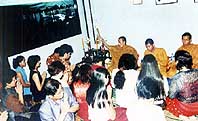 Revered
monk Phra Khru Patrakijviboon (Acharn Kan) sprinkles holy water to bless the
Pattaya Mail staff, offices and friends. Revered
monk Phra Khru Patrakijviboon (Acharn Kan) sprinkles holy water to bless the
Pattaya Mail staff, offices and friends.
Managing director Peter Malhotra re-affirmed his
intention to keep the Pattaya Mail as the leading voice for Pattaya, not
only for the English speaking population, but in addition for the many Thais
who now also read the weekly newspaper.
 Eddie
and King revel in the atmosphere Eddie
and King revel in the atmosphere
The Pattaya Mail was started because there was a need to
counter some of the prejudiced reporting from overseas regarding Pattaya,
and it has been from that niche that the Pattaya Mail has grown into being
the primary resource medium on Pattaya for the rest of the world. Now, with
the Pattaya Mail’s on-line website being upgraded every week, it receives
more than 70,000 hits a day from overseas.
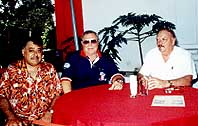 Pattaya
Mail MD Peter Malhotra (left), the former president of the Pattaya Sports
Club with new PSC president Carl Engel (center) and PSC party chairman Ken
Crow Pattaya
Mail MD Peter Malhotra (left), the former president of the Pattaya Sports
Club with new PSC president Carl Engel (center) and PSC party chairman Ken
Crow
The promotion of Pattaya by the Pattaya Mail has remained
top priority, but Peter Malhotra said that this could not be done by just
glossing over problem areas in the city. At times it has been necessary for
the newspaper to highlight these problems to initiate some action (or
reaction) from the bureaucracy.
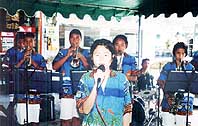 The
band from Pattaya City School No. 3 entertained the crowd The
band from Pattaya City School No. 3 entertained the crowd
From its very humble beginnings, with a skeleton staff,
the Pattaya Mail has grown, not only in staff, in size, but also in stature,
winning the accolade of “Best in the East” now for many years. However,
neither Peter Malhotra nor his hard working team of over 40 staffers will
allow the grass to grow under their feet. They have had the right product
for the times for the past 8 years and intend to continue in that vein for
at least another 8.
 Amrik
Singh Kalra (left), leader of the Pattaya Indian Community, and
Santsak Ngamphiches (right), consultant chairman to the Minister of
Science, Technology and Environment enjoy a laugh with Pattaya Mail MD
Peter Malhotra Amrik
Singh Kalra (left), leader of the Pattaya Indian Community, and
Santsak Ngamphiches (right), consultant chairman to the Minister of
Science, Technology and Environment enjoy a laugh with Pattaya Mail MD
Peter Malhotra |
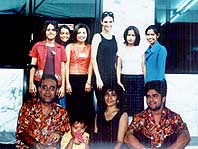 Future
Miss Thailand Worlds perhaps? Posing with the former Miss Thailand
World Cindy Burbridge Future
Miss Thailand Worlds perhaps? Posing with the former Miss Thailand
World Cindy Burbridge |
 Pattaya
Mail’s beautiful staff were on hand to welcome people to the party Pattaya
Mail’s beautiful staff were on hand to welcome people to the party |
 Pattaya
Mail’s men enjoy the moment with former Miss Thailand World Cindy
Burbridge Pattaya
Mail’s men enjoy the moment with former Miss Thailand World Cindy
Burbridge |
 PSC
charity chairman Bernie Tuppin gets some cooling refreshment in the
afternoon heat PSC
charity chairman Bernie Tuppin gets some cooling refreshment in the
afternoon heat |
 Peter
greets Clare and Judy Clausen Peter
greets Clare and Judy Clausen |
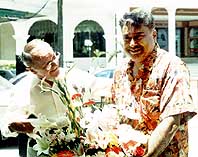 Bruno
Forrer of the world famous Bruno’s Restaurant offers his
congratulations and a bouquet of beautiful flowers Bruno
Forrer of the world famous Bruno’s Restaurant offers his
congratulations and a bouquet of beautiful flowers |
 Peter
chats with Royal Cliff GM Andrew Wood (center) and Pattaya Mail
columnist Leslie Wright (right) Peter
chats with Royal Cliff GM Andrew Wood (center) and Pattaya Mail
columnist Leslie Wright (right) |
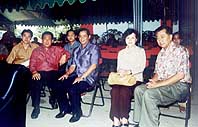 (L
to R) Poramate Ngampiches, Chanyut Hengtrakul, advisor to the Minister
of Science, Technology and Environment, Manit Boonchim, director of
the TAT Central Region 3 Office in Pattaya, Sophin Tappajug, the
associate judge to the Chonburi court’s juvenile and family case
section, and Yuthapong Srimethakul presented their best wishes. (L
to R) Poramate Ngampiches, Chanyut Hengtrakul, advisor to the Minister
of Science, Technology and Environment, Manit Boonchim, director of
the TAT Central Region 3 Office in Pattaya, Sophin Tappajug, the
associate judge to the Chonburi court’s juvenile and family case
section, and Yuthapong Srimethakul presented their best wishes. |
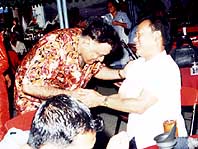 Thonglor
Ampueng President of the Pattaya Mass Media Club offers his
congratulations Thonglor
Ampueng President of the Pattaya Mass Media Club offers his
congratulations |
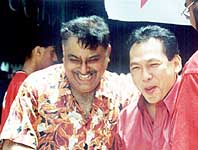 Chanyut
Hengtrakul (right), advisor to Chanyut
Hengtrakul (right), advisor to
the Minister of
Science, Technology
and Environment
celebrate many
years of close friendship |
Hill Tribe Children:
Empowered and Impressive
|
The Hill Tribe peoples, numbering
just over one million out of Thailand’s population of 62 million (as
of 1999), have long been marginalized, cultivating the opium poppy as
the only means of survival in an alien - and often hostile -
environment. Inevitably, the onslaught of materialism engulfed them
with a disastrous outcome for the Hill Tribe children, presenting an
image of impoverishment, drug abuse, and in many cases, innocent
victims of HIV/AIDS.
On the initiation of His Majesty the
King, in establishing the Royal Projects and, more recently, the
collaboration of the Royal Project Foundation (RPF), the National
Council for Child and Youth Development (NCCYD) under the Royal
Patronage of HRH Crown Princess Sirindhorn and the United Nation’s
Children’s Fund (UNICEF), a new life - one of hope and
accomplishment - has emerged. Gone is the image of haunted faces,
enslaved to drug-addiction and the many vices concomitant with this
curse.
Pattaya Mail special
correspondent Peter Cummins was commissioned by UNICEF to visit some
of the Hill Tribe villages close to Chiang Mai last week and reports
here for the Mail. |
story and photos by Peter Cummins
UNICEF and children’s rights
In accordance with its obligations to protect ALL
children EVERYWHERE, UNICEF is constantly exploring ways and means to
protect children and ensure their rights which, under the articles of the
“Convention of the Rights of the Child” include the right to participate
in matters which affect them. The plight of Thailand’s Hill Tribe
children, particularly, is highly relevant to UNICEF’s mandate.
 Hmong
girl Supaporn (20) stands proudly in front of her ‘cabbage patch’ at the
Royal Nong Hoi Project Hmong
girl Supaporn (20) stands proudly in front of her ‘cabbage patch’ at the
Royal Nong Hoi Project
Just last week, in fact, UNICEF went to some Hill Tribe
areas outside Chiang Mai, specifically the Ban Nong Hoi Royal Development
Center, to discuss progress with the children and young adults there. They
positively exuded enthusiasm, confidence and a self-reliance which did not
end at the village steps. Quite the contrary; they discussed animatedly the
status of their own cash crops, the competition as to who was the most
successful farmer/marketeer and - with much laughter and good humour - who
amongst them had not “done so well” over the past few months.
Nong Hoi Centre
A microcosm of the success of the Hilltribe Youth Career
and Leadership Development Project (HYCLPD) is the Nong Hoi Development
Centre, located in the Nong Hoi Village, Tambon Mae Raem, Mae Rim District,
some 40 km from Chiang Mai. It is a remarkably beautiful area of
approximately 13,000 rai, comprising thickly wooded areas juxtaposed to
cultivated plots alternately clinging to the hillsides and dropping into the
valleys, spread between two watersheds above the Ping River.
 The
entrance to Nong Hoi: a gateway to new life - the Royal Nonghoi Project The
entrance to Nong Hoi: a gateway to new life - the Royal Nonghoi Project
Being 1,200 m above sea level, the climate is ideal for
temperate fruits and vegetables which, like the people in the area, thrive
on the somewhat rarefied air and the misty surroundings.
Chairman of the Nong Hoi Youth Group is 22-year-old
Yongyuth who obviously revels in his leadership responsibilities and sets
the example for the newer and younger members of the group. Yongyuth liaises
with the village chief and the Royal Project Director to formulate
programmes, assist his tribal siblings to select an appropriate occupation
and monitor progress through meetings with network counterparts from other
villages. Yongyuth is one of 280 hilltribe youth who are participating in
the Hilltribe Youth Project supported under UNICEF’s Child Protection
Programme.
 A
group of the Nong Hoi Networkers: youth leaders Yongyuth (second left) and
Moorakit (left) set a fine example for their peer group at the village A
group of the Nong Hoi Networkers: youth leaders Yongyuth (second left) and
Moorakit (left) set a fine example for their peer group at the village
Each young participant can submit a request to start a
particular income-generating activity after one full week of life-skills and
leadership training,
Yongyuth, with only an ‘informal education’ up to the
equivalent of grade nine, has reaped immense benefit from his crops,
marketed through the Royal Projects outlets, and has thus been able to
contribute much to the welfare of all in the village. Growing and marketing
rose apples and spinach, the money thereby earned is ploughed back into the
community funds from which an individual can draw to follow a pursuit -
agricultural or otherwise - that has been approved by the Project.
Empowerment
UNICEF, which works through the National Council for
Child and Youth Development (NCCYD) for the benefit of the Hill Tribe
children, is especially concerned with the girls whose vulnerability to
exploitation and abuse is only too evident. Girls are selected to join the
agricultural activities only if the family approves and then they are
trained to be able to participate fully in the village’s agricultural
pursuits and, in the process, gain self-respect and confidence, allowing
them to avoid the pitfalls waiting to ensnare them.
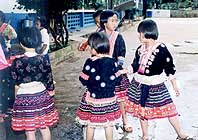 Hmong
children in the Nong Hoi School playground: now there is a future Hmong
children in the Nong Hoi School playground: now there is a future
Among UNICEF’s aims are the empowerment of more girls
– not forgetting the boys, of course – through family and the community
network. The training is not only to help the young people to become
confident, productive and proud but – and more importantly – to teach
them to be highly aware of and thus eschew the evils and temptations of an
alternate life leading to degradation, drug abuse and HIV/AIDS.
Three cheerful, vibrant Hmong girls, led by their
‘mentor’ Supaporn, joined the discussions at Nong Hoi. Supaporn was
proud of her very own “cabbage patch”. But she has contributed much more
than a cash crop to help the community; she has been the inspiration to
bring her siblings into the village mainstream and join fully the
activities.
From there, each girl will be a catalyst to bringing in
more of the girls of the village, saving them, in turn, from the possible
awful alternatives.
 Youth
volunteers check the crops Youth
volunteers check the crops
One of the boys in the group had not been so successful
and his approved project of pig husbandry had failed. The pig died. “He
tried to save money by cutting down on pig food,” one of the girls
giggled. Yongyuth, a true leader, rescued his unfortunate prot้g้
who now farms zucchini and pumpkin - “very well”, said Yongyuth.
Another of the boys, Morakot, Yongyuth’s committee
member, was very happy with his lot. At the neighbouring village of Mae Sa
Mai, Morakot has a “black” chicken farm, pointing out with a grin, that
due to the beliefs of some people, the black chicken brings a better market
price. He is also embarking on a fish-farming project.
What an incredible difference NCCYD has made to the lives
of these young people. Like Yongyuth, Supaporn is very proud of her
achievements and is looking to improve the lot of even more of the village
girls.
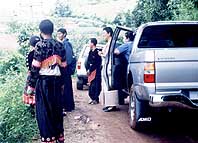 Royal
Project and UNICEF staff join the youth volunteers for an overview of the
Project Royal
Project and UNICEF staff join the youth volunteers for an overview of the
Project
UNICEF, which monitors the progress in each of the 35
villages in the network, looks to continue support when this present phase
finishes at the end of this year.
The advancement of the young people is not just limited
to agriculture, however. There are opportunities for training in local
crafts and other skills, as well as further education but, UNICEF notes,
there is a dire lack of information. Although any one of the children and
young adults has access to the Project Director for guidance and assistance,
there is virtually no printed information available to the youngsters.
Crops for cash
 Experimental
hydroponic crops at Nong Hoi Experimental
hydroponic crops at Nong Hoi
Fancy a yellow sweet pepper? A cabbage? Some spinach? Or,
perhaps, a black chicken - reputed, by some groups, to have medicinal value?
What about a head of crisp, green lettuce for that fresh salad you were
wanting to prepare? And you can throw in some equally fresh tomatoes,
Chinese celery, carrot and radish and spice it all up with a few herbs. The
merchandise is so fresh that you can almost smell the earth of the hill
stations around Chiang Mai where the produce was grown, and feel the cool,
invigorating mountain mists which nurtured them.
These items are produced at Ban Nong Hoi and Ban Mae Sa
Mai, which are but two of the Royal Project Foundation’s 35 centres
established in the northern areas around Chiang Mai, Chiang Rai, Lumphun,
Mae Hong Son and Phayao.
The Royal Development Projects
It was in 1969 when His Majesty the King, vitally
concerned about the addiction to and the cultivation of opium by the Hill
Tribes, initiated the Royal Development Project, established with his own
personal funds. The King was fully aware of their plight and that their
slash-and-burn agricultural practice was de-foresting vast areas and
destroying the watersheds of the north; its destructive side-effects spelled
disaster to the Tribes themselves, as well as the environment and the
fragile ecology.
 The
“black chicken” farm The
“black chicken” farm
Keenly observing this dilemma, H.M. the King established
the Royal Project Foundation, acting himself as the Honorary President, with
HSH Prince Bhisadej Rajani as chairman of nine appointed committees, the
prime aim being, “To help the Hill Tribes help themselves.”
Under the dynamic direction of H.M. the King’s close
associate, M.C. Bhisadej Rajani, the Royal Project’s development centres,
in just over three decades, have added four research stations and now
incorporate 295 villages, comprising 14,000 households totalling some 85,000
farmers.
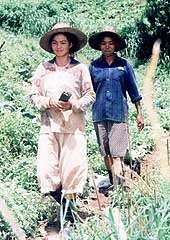 Coming
down for a rest after work on the hillside Coming
down for a rest after work on the hillside
As this correspondent observed last week, the forests
have re-grown and the erstwhile bald hills are now covered in luxurious
foliage and flora. A huge number of cash crops, such as those mentioned
above, have replaced the opium poppy as the Hill Tribes’ livelihood. So
successful have been the Royal Projects, in fact, that in 1998 they were
accredited with the “Magsaysay Award for International Understanding”
and the “Thai Expo Award” for attaining to the, “Highest quality
standard of Thai goods for export.”
Regardless of the success of the Royal Projects, however,
there was an alarming disaffection among Hill Tribe children who were being
subjected - and in many cases, succumbing - to bad influences, direct
by-products of the onslaught of materialism: drug abuse, anti-social
tendencies, inappropriate sexual behaviour. “Easy money” from hordes
exploiting the children has further corrupted the traditional Hill Tribe way
of life.
 Examining
the “fish-farm” at Mae Sa Ma Examining
the “fish-farm” at Mae Sa Ma
As a result, many young people fled to the nearby
“big” cities, there to fall victims of exploitation, of abuse, drugs and
HIV/AIDS. This exodus had another pejorative effect: it was depriving the
people themselves of the young human resources so essential to developing
and sustaining the precarious and fragile communities.
From this, in early 1999, the Royal Project Foundation (RPF),
the National Council for Child and Youth Development and UNICEF joined
forces to establish the “Network of Hilltribe Youth Volunteers”,
designed to be, “A learning process for self-reliance and social
participation of Hilltribe youth”. These three main supporters who
contribute financial, technical and human resources are joined at various
relevant stages by government agencies, non-governmental organizations,
community leaders, youth groups and staff of the Royal Project Centres who
all contribute appropriate expertise.
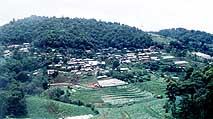 The
Nong Hoi station from the opposite hilltop The
Nong Hoi station from the opposite hilltop
Now, entering the latter stage of the most successful
first phase, from December 1999 to December 2001, this project is building
the capacity of Hilltribe youth living in the operating areas of the Royal
project’s 35 centres.
The first step was to select and train youth volunteers,
support their career development activities and establish the network. Some
300 Hill Tribe and other young people in the highland areas have now been
trained to be self-reliant and mobilize other youth groups in the network.
Through this impressive empowerment of youth, some 74,000
tribes people from 280 villages are now becoming the beneficiaries of this.
For the youth themselves, the former degradation and
exploitation through drugs and other evils are now but evaporated smoke from
some distant “pipe dream”!
Updated every Friday
Copyright 2001 Pattaya Mail Publishing Co.Ltd.
370/7-8 Pattaya Second Road, Pattaya City, Chonburi 20260, Thailand
Tel.66-38 411 240-1, 413 240-1, Fax:66-38 427 596; e-mail: [email protected]
Updated by
Chinnaporn Sungwanlek, assisted by Boonsiri Suansuk.
E-Mail: [email protected]
|

The Rotary Club
of Jomtien-Pattaya

Skal
International

Pattaya
Fun City
By The Sea
|